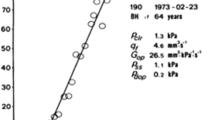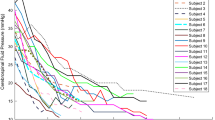Summary
This investigation has been undertaken to analyze the findings with both the cerebrospinal fluid (CSF) pressure (Pcsf) and CSF pulse pressure (PP) in order to predict the outcome of patients with the syndrome of idiopathic normal pressure hydrocephalus (NPH). Accordingly, a prospective clinical study was planned in which two groups of patients with NPH, having analogous prevalence of several matched clinical and radiological parameters, were separated on the basis of their positive or negative response to shunting. Both the resting Pcsf and CSF PP profiles were compared in these two groups, and between them and normal controls. CSF PP amplitude and CSF PP latency correlated directly in conditions associated with either normal or high compliance (controls and patients with Alzheimer-like disorders), whereas this correlation was inverse in states of low compliance (NPH). On the other hand, shunt-responders showed a resting Pcsf significantly higher than both non-responders and controls.
The following conclusions were obtained: 1) CSF PP is a high-amplitude and relative low-latency wave in NPH when compared with controls; 2) CSF PP amplitude and latency correlate directly in normal subjects and in those with primary cerebral atrophy; 3) a non-reversible stage of NPH could be conceived in contradistinction to the reversible one, in both of which an inverse correlation between the amplitude and the latency takes place, the main difference between them being the resting Pcsf, which is significantly lower in the former than in the latter, depending on the degree of atrophic changes developed.
Similar content being viewed by others
References
Albeck MJ, Børgesen SE, Gjerris F, Schmidt JF, Sørensen PS (1991) Intracranial pressure and cerebrospinal fluid outflow conductance in healthy subjects. J Neurosurg 74: 597–600
Bradley WG Jr, Whittermore AR, Watanabe AS, Davis SJ, Teresi LM, Homyak M (1991) Association of deep white matter infarction with chronic communicating hydrocephalus: implications regarding the possible origin of normal-pressure hydrocephalus. AJNR 12: 31–39
Bret P, Chazal J, Janny P, Rénaud B, Tomassi M, Lemaire JJ, Bret M, Jouvet A (1990) Hydrocéphalie chronique chez l'adulte. Neurochirurgie [Suppl] 36: 1–159
Foltz EL (1984) Hydrocephalus and CSF pulsatility: Clinical and laboratory studies. In: Shapiro Ket al (eds) Hydrocephalus. Raven, New York, pp 337–361
Foltz EL, Aine C (1981) Diagnosis of hydrocephalus by CSF pulse-wave analysis: a clinical study. Surg Neurol 15: 283–293
Foltz EL, Blanks HP (1988) Symptomatic low intracranial pressure in shunted hydrocephalus. J Neurosurg 68: 401–408
Foltz EL, Lederhaus S (1979) Ventricular CSF pulse pressure amplitude: an index of intracranial compliance. In: Marguth Fet al (eds) Advances in neurosurgery. Springer, Berlin Heidelberg New York, pp 295–304
Gjerris F, Børgesen SE (1992) Current concepts of measurement of cerebrospinal fluid absorption and biomechanics of hydrocephalus. Adv Tech Stand Neurosurg 19: 145–177
Hakim CA (1985) The physics and physicopathology of the hydraulic complex of the central nervous system. (The mechanics of hydrocephalus and normal pressure hydrocephalus). Thesis. MIT, Massachusetts
Janny P, Colnet G, Veyre A, Chazal J, Barreto LC (1981) Hydrocéphalie a pression normale. Etude pré- et postoperatoire de 56 cas. Neurochirurgie 27: 89–96
Kimura M, Tanaka A, Yoshinaga S (1992) Significance of periventricular hemodynamics in normal pressure hydrocephalus. Neurosurgery 30: 701–705
Kosteljanetz M (1987) Intracranial pressure. Cerebrospinal fluid dynamics and pressure-volume relations. Acta Neurologica Scand [Suppl] 75: 1–23
Kosteljanetz M, Ingstrup HM (1985) Normal pressure hydrocephalus: correlation between CT and measurements of cerebrospinal fluid dynamics. Acta Neurochir (Wien) 77: 8–13
Lamas E, Lobato RD (1979) Intraventricular pressure and CSF dynamics in chronic adult hydrocephalus. Surg Neurol 12: 287–295
Larsson A, Jensen C, Bilting M, Ekholm S, Stephensen H, Wikkelso C (1992) Does the shunt opening pressure influence the effect of shunt surgery in normal pressure hydrocephalus? Acta Neurochir (Wien) 117: 15–22
Meyer JS, Kitagawa Y, Tanahashi N, Tachibana H, Kandula P, Cech DA, Rose JE, Grossman RG (1985) Pathogenesis of normal-pressure hydrocephalus. Preliminary observations. Surg Neurol 23: 121–133
Meyer JS, Tachibana H, Herdenberg JP, Dowell RE, Kitagawa Y, Mortell KF (1984) Normal pressure hydrocephalus. Influence on cerebral hemodynamic and cerebrospinal fluid pressure — chemical autoregulation. Surg Neurol 21: 195–203
Pappadá G, Poletti C, Guazzoni A, Sani R, Colli M (1986) Normal pressure hydrocephalus: relationships among clinical picture, CT scan and intracranial pressure monitoring. J Neurosurg Sci 30: 115–121
Rubin RC, Hochwald GM, Tiel M, Mizatani H, Ghatak N (1976) Hydrocephalus: I. Histological and ultrastructural changes in the pre-shunted cortical mantle. Surg Neurol 5: 109–114
Rubin RC, Hochwald GM, Tiel M, Liwiez BH (1976) Hydrocephalus: II. Cell number and size, and myelin content of pre-shunted cortical mantle. Surg Neurol 5: 115–118
Turner DA, McGeachie RE (1988) Normal pressure hydrocephalus and dementia — evaluation and treatment. Clin Geriatr Med 4: 815–830
Weller RO, Mitchel J (1980) Cerebrospinal fluid edema and its sequelae in hydrocephaly. Adv Neurol 28: 111–123
Weller RO, Shulman K (1972) Infantile hydrocephalus; Clinical, histological and ultrastructural study of brain damage. J Neurosurg 36: 255–256
Author information
Authors and Affiliations
Rights and permissions
About this article
Cite this article
Bárcena, A., Mestre, C., Cañizal, J.M. et al. Idiopathic normal pressure hydrocephalus: Analysis of factors related to cerebrospinal fluid dynamics determining functional prognosis. Acta neurochir 139, 933–941 (1997). https://doi.org/10.1007/BF01411302
Issue Date:
DOI: https://doi.org/10.1007/BF01411302




